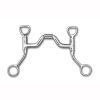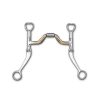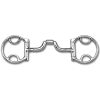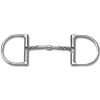Myler Bit Levels
The Myler bitting system differs to many others in that it utilizes a graduated system whereby your horse is bitted based on its disposition and level of experience. As your horse progresses and advances through the Myler bitting system (there are 4 different levels in total), it is rewarded with a greater amount of tongue relief.
Level 1

The level 1 Myler bits are ideally suited to young horses that are just beginning their training and still have a challenging disposition. The rider will likely be aiming to teach balance and a few basic commands (simple turns, walk to halt etc), with the horse having few to no real skills and understanding at this point. A few of the main features of Level 1 Myler Bits include:
- The bit rotates onto the tongue when the rider wants to apply tongue pressure.
- When released, the bit collapses into a U shape as opposed to a V shape, which protects the horse against pinching.
- A curved design ensures neither the lips nor the bars are subjected to excess pressure or pinching.
- The majority of Level 1 bits possess Myler’s Independent Side Movement technology.
The Level 1 bit range is designed to allow the rider to apply concentrated tongue pressure (depending on the exact bit selected, a certain amount of bar, curb or poll pressure may also be applied) to provide the horse with clear instructions, and then quickly release that pressure to reward the horse if they do as instructed.
Level 2

The Myler bits found in the Level 2 range are suitable for horses in several categories. They are most commonly used with younger horses that have completed basic training, but equally they are suitable for an older horse that is being retrained after a lengthy period of inactivity or is being trained for a new discipline. Some of the main features of Level 2 Myler bits include:
- A small port and/or a greater degree of flexibility in the mouthpiece to provide extra tongue relief.
- The bit rotates onto the tongue to apply tongue pressure.
- When the reins are held in a relaxed position, the mouthpiece collapses into a U shape, ensuring the lips and bars of the horse are not pinched.
- The design of these bits features a curved shape that provides extra space for the tongue and reduces the pressure exerted on the lips and bars.
- Most of the bits in the Level 2 range have the Independent Side Movement feature.
Level 2 Myler bits offer the horse reward for following simple commands during basic training and rather than applying a concentrated tongue pressure, they utilize tongue pressure that is more spread out. At this point the horse is not ready to be able to work with total tongue relief and the ISM feature becomes vital as training steadily gets more difficult and the need for clear, precise signals is essential.
Level 2 – 3

A horse that has completed basic training, demonstrates a good disposition along with good self control is an ideal candidate for a Level 2 – 3 bit. Horses that have undergone advanced training, but display a challenging disposition (often becoming either anxious, fearful or aggressive) are also suited to a Level 2 – 3 bit. The main features of these bits include:
- Ported mouthpieces that provide the horse with more tongue relief than bits found in Levels 1 & 2.
- The range features a number of correctional mouthpieces that are designed in a way that applies some tongue pressure, as well as some curb mouthpieces that apply very little tongue pressure.
- More of an emphasis placed on utilizing bar, poll and chin pressure than those bits that make up Levels 1 & 2.
- An inherent feature with all Myler Bits, the Level 2 – 3 range features a curved design to ensure maximum comfort when inside the horse’s mouth and more room for the tongue.
- Bits available with and without the Independent Side Movement feature.
Level 2 – 3 bits don’t utilize tongue pressure as heavily to communicate with the horse and offer significantly more relief. You might also consider progressing a horse that is currently in a Level 2 bit and showing resistance to this level, as this is the horse’s way of communicating to you that the amount of tongue pressure exerted by their current bit is too high.
Level 3

The final level in the Myler range should only be utilized with experienced performance horses that have undergone advanced training and possess a very trustworthy disposition. These horses are typically very relaxed and have the ability to understand a wide range of commands from the rider. The most important features of Level 3 Myler bits include:
- Curb bit designs than feature wider ports that provide the horse with the maximum amount of tongue relief, applying very little to no pressure whatsoever.
- Bar, poll and curb pressure are primarily used to communicate with the horse as opposed to tongue pressure.
- Curved mouthpiece design to allow more space for the horse’s tongue.
- Bits available with and without Myler’s Independent Side Movement feature.
At Level 3 you are not relying on tongue pressure to communicate with your horse so it’s vital that you have developed a good understanding and that there’s a high degree of trust. The exact bit that should be selected will be dictated by the horse’s disposition.





